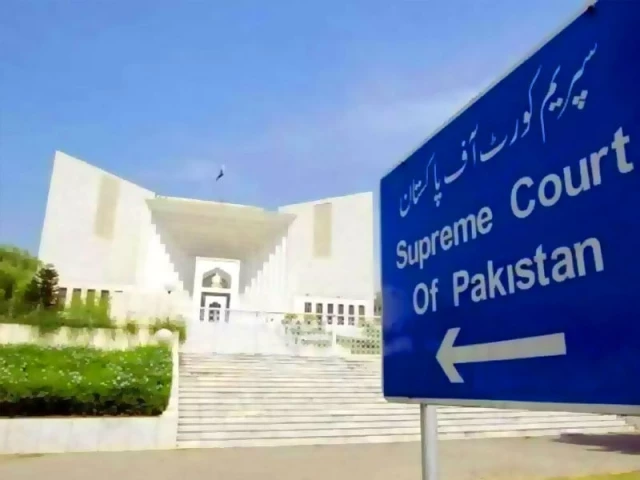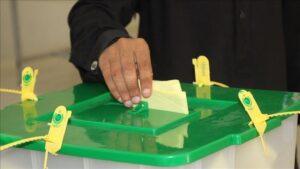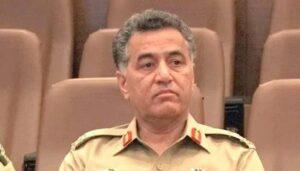ISLAMABAD:
The Supreme Court on Thursday held a debate on the composition of the court competent to hear petitions against the 26th Constitutional Amendment, as a lawyer for the petitioners urged that the case be referred to a bench composed of the 16 judges of the Supreme Court, who formed the full court before the amendment.
An eight-member constitutional bench (CB) of the Supreme Court, headed by Justice Amin-ud-Din Khan, on Thursday heard petitions against the 26th Constitutional Amendment, which brought about sweeping changes in the judiciary, including the formation of CBs in the SC and high courts.
During the hearing, senior advocate Munir A Malik, representing the Balochistan Bar Council and the Balochistan Bar High Court, said he adopted the arguments presented by advocate Hamid Khan but also wanted to make some additional submissions.
When Justice Jamal Khan Mandokhail pointed out that Hamid Khan was not defending the current full court but a 16-member bench, Malik replied that his position was the same. “The case must be heard by the full court as it existed before the amendment,” he said.
Justice Mandokhail observed that such a court would not be a full court but a larger court.
Malik said he wanted to read Article 191-A of the Constitution.
He said the 26th Amendment does not say that the Supreme Court will exercise its powers solely through an OC. The CB is part of the Supreme Court itself, it is not a separate entity.
“The definition of the Supreme Court is found in article 176 of the Constitution, which states that the Supreme Court is composed of the president of the Supreme Court and all the judges. My position is that this case should be heard by the Supreme Court as a whole.”
Justice Mandokhail asked whether a court consisting of all judges would not continue to be called a court. Munir Malik responded in the negative and stated that it would be called the Supreme Court in banc (full court), which he said is a universally recognized practice.
Justice Ayesha Malik noted that there is a convention related to this and no court order prevents the formation of a full court. Justice Muhammad Ali Mazhar asked if the CB issued such an order and to whom it would be addressed.
Malik responded that such an order would apply to all authorities under the Constitution. Justice Mandokhail asked if the court issued such an order, whether the full court would be called CB.
Malik said his argument is that Article 191-A did not change the definition or powers of the Supreme Court. A full court, acting as the Supreme Court, can hear this case.
“The powers of the Supreme Court can only be eliminated by abolishing the court itself. Article 176 remains unchanged in the Constitution. A full court should be called the Supreme Court; the term court is alien to the Constitution.”
Justice Mandokhail observed that the 26th Amendment did not actually restrict the jurisdiction of the Supreme Court. “However, the Judicial Commission of Pakistan (JCP) can form a Constitutional Bench comprising all judges,” he said.
Justice Amin-ud-Din Khan asked whether the CB should ignore Article 191-A and pass an order.
Justice Ayesha Malik said Article 191-A does not eliminate the judicial powers of the SC. “He is himself under challenge before us. Why should we move forward by supporting him first?”
Justice Muhammad Ali Mazhar asked what was the justification of the existing court if Article 191-A was to be ignored. Justice Amin-ud-Din Khan pointed out that the same court was constituted by a committee formed through the 26th Amendment.
Malik responded that his argument was simple: that nothing prevented the court from issuing an injunction.
During the hearing there was an exchange of comments between the judges.
Justice Musarrat Hilali said the court must go back to square one and examine whether the amendments that followed violated fundamental rights. “Judges appointed after the 26th Amendment cannot hear this case,” he added.
Justice Mandokhail, however, disagreed with this view and asked whether the new judges appointed after the amendment were imported from some other country.
Justice Mazhar observed that the appointment of Supreme Court judges had no bearing on the amendment. “The number of Supreme Court justices was increased by law, not by the 26th Amendment,” he said.
Justice Ayesha Malik said those judges, however, were appointed to the Supreme Court in accordance with the procedure established in the 26th Amendment.
Responding to Malik’s claim that only those judges who were on the Supreme Court before the 26th Amendment should hear the case, Justice Mandokhail asked how the CB could exclude brother judges.
Justice Hilali noted that the fate of judges appointed after the 26th Constitutional Amendment depended on the outcome of the case. “Whether they will remain judges of the Supreme Court or not will be known once the verdict is announced,” he said.
Justice Mandokhail asked where the judge would go if the court struck down the amendment. Malik responded that the judge would return to their respective higher courts.
The court later adjourned the hearing until Monday.




